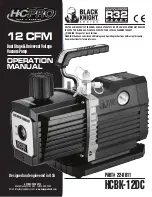
501-K00 Page 6/12
OPERATION
Operation without guards in place can
cause serious personal injury, major
property damage, or death.
Do not operate
without guard
in place
Failure to relieve system pressure prior
to performing pump service can cause
serious personal injury or property
damage.
Systems with meters will still
be pressurized even after the hose is
emptied
Hazardous pressure
can cause serious
personal injury or
property damage
Disconnecting fluid or pressure
containment components during pump
operation can cause serious personal
injury or property damage.
Hazardous pressure
can cause serious
personal injury or
property damage
Pumps operating against a closed valve
can cause system failure, personal injury
and property damage
Hazardous pressure
can cause personal
injury or property
damage
PRE-START UP CHECK LIST
1. Inspect complete piping system and supports to ensure
that no piping loads are being placed on the pump.
2. Verify proper coupling alignment.
3. Install pressure gauges in the 1/4" NPT intake and
discharge ports located on the pump casing to check
pump performance after start-up.
4. Ensure all valves and fittings in piping system are in the
start-up or operating positions.
5. Jog the pump motor to verify proper pump rotation. If
rotation is incorrect, reverse rotation of motor.
START UP PROCEDURES
NOTICE
Consult the "Troubleshooting" section of this manual if
difficulties during start up are experienced.
1. Start the motor. Priming should occur within one minute.
2. Check the pressure gauges to ensure the system is
operating within expected parameters. Record the
gauge readings in the "Initial Start Up Information"
section of this manual for future reference.
3. Inspect piping, fittings, and associated system equipment
for leaks, noise, vibration and overheating.
4. Check the flow rate to ensure the pump is operating
within the expected parameters. Record flow rate in the
“Initial Start Up” section of this manual.
5. Close the discharge valve and check the differential
pressure across the pump. It should not exceed the
pressure setting of the external bypass valve.
6. With the discharge valve still closed, momentarily close
the manual shut-off valve in the bypass return line to
check the pump relief valve. The pressure should be at
least 25 PSI (1.7 bar) higher than the maximum system
operating pressure or the system pressure control valve
setting.
7. The external bypass valve must always be set at least 25
PSI (1.7 bar) lower than the internal pump relief valve.
NOTE -
The normal operating pressure should be at
least 5 - 15 PSI (0.3 -1.0 bar) less than the external
bypass setting. Pump speeds which result in higher
pressures (nearing the valve setting) forces the liquid to
be recirculated, creating excessive wear on the pump
and equipment.






























